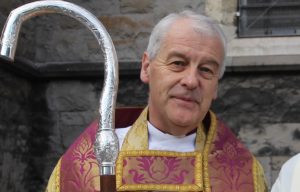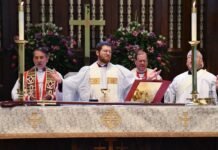St John 1.1 and 3: …what God was, the Word was … without him no created thing came into being.
Within the life of the Church of Ireland, there is a number of fixed points for churchgoing people. The Harvest Thanksgiving is one of these. As the return to school nudges further back into the month of August, it is the harvest that effectively kicks off the autumn season in parochial church life; the return to school is just too early for most of us to start church seriously again. Another fixed point that has emerged in recent times is the increasingly commemorative use of the month of November. If you go back twenty–five years, you’d find few parishes in the Church of Ireland countenancing All Saints’ Day; even fewer parishes countenancing All Souls’ Day; and yet at the same time a great number of parishes countenancing Remembrance Sunday both in The Republic of Ireland and in Northern Ireland. The month of November seems recently to have become a month of widespread remembrancing across the broad sweep of the church in ways that are helpful to many people as they come to terms with loss, a loss that frequently deepens rather than lessens as the years pass by. There is a great need for this month in today’s world not least with regular religious observance waning along with its accompanying liturgical and ritual expressions and involvements.
Harvesting and Remembrancing come together in the recognition of God’s goodness and our needfulness, both of which seem unfathomable to us for different reasons. There is a harvesting of produce, a harvesting of values and inevitably a harvesting of life itself. We need now to make another connection, the vibrant connection between Harvesting and Christmas not solely for the distribution of generosity and goodwill, but also in the rather obvious yet powerful recognition that there is a connection between garnering and creating. You cannot reap what you do not sow. For those of us with an eye to international weather patterns as well as to international power patterns, both creation and harvest are under threat in ways about which we have never been informed so comprehensively as we are now. We know what is going on meteorologically and politically as they happen before our eyes. And this surely is one of the problems with information: you cannot unknow what you come to know. So, where are we to go next? My suggestion is a radical reconsideration of Christmas itself.
There is, to my mind, scope for an urgent reset of Christmas. Many complain that Christmas has become too commercialized, too materialistic. Fewer take the next step, that is to do the difficult but rewarding work of finding and sharing the richness and the riches of the Christian tradition about Christmas that is to be found in the Scriptures and as our own Christmas traditions have developed them over time. Yes, it is commercial; but, yes, it remains Godly. Our annual insistence in this cathedral church, under the guidance of The Dean and heading now towards its millennial anniversary, on reading The Prologue of St John’s Gospel every Christmas Day facilitates us in finding the pearl of great price in the total Christmas experience. St John 1.1–14, or even better 1–18, brings us to the cosmic mystery at the heart and the life of creation. This is the true gift of The Gospel to us on Christmas Day. Why is this important for a reset of our understanding of Christmas? It is because it places the material, which facilitates our consumerism, in the larger vista of the incomprehensible; what we control in the realm of what we cannot control. This is a good reset for our spiritual understanding. Not least for people who express our faith by going to church, by being in church, we can lose our way through the regularity, the predictability of what is going on. Learning once again to cope with what we cannot control is good for us. It takes us into the heart and the mind and the being of God.
This is where we are to abide at Christmas as God comes to abide with us in the person of Jesus Christ. And this is so very important as we prepare to enter the year 2025. In that year we will mark, we will remembrance, the seventeen hundredth anniversary of The Council of Nicaea from which emerged the public statement and the foundational ideas of The Nicene Creed. The Creed shows us that Christianity is an open and a public expression of religion. The Council plants firmly in the ground for the church yet to come the tent pegs of Trinitarian doctrine and church response in worship, prayer, action and communion. Nicene orthodoxy still matters. The reality of incarnation is central to it. And so, Christmas matters every single day of the year.
I have spoken of the creation as an organic mystery. I want to speak of it more immediately as a place of holiness. The creation in St John’s Gospel is the point of incarnation. This is why abuse of the creation is so problematic especially when it is perpetrated by people of faith. For self–consciously Christian people, holiness, the Kingdom of God and the Eucharist are intimately linked. All three are gifts of the Spirit and in so many ways flow from Christmas properly understood. St John 1 shows us that the creation is not confined to the way in which we use this term now: the inhabited earth. It is the creation of the cosmos, defined first and foremost by its vastness and by its unknown–ness, to which we are introduced here and now on Christmas Day. Its primary relationship is with God, and it has a further relationship with the angels about whom we have effectively forgotten as living rather than imagined beings. Whatever, whomever, they are and represent, they have been doing it for thousands of years and have still not gone away. Holy Communion is vital to our understanding of creation. In the Eucharist, the thanksgiving itself is defined by the fact that creation, creator and created come together and the encounter is one of transformation. This is remembrancing in a whole new register. It is thanks to The Nicene Creed and its own dogged determination to define rather than assume doctrine – that Jesus Christ is not part of the creation nor is the Holy Spirit part of creation, an insight for which church people went to their death in their day. As a result of this, we are able to enjoy this thanksgiving of thanksgivings on Christmas Day and on every other day of the year in finding communion with God in the bread and wine of the holy creation within the community of faith.
A third thing which you will not need me to point out to you is the dogged determination of Jesus Christ to abide in his creation throughout the Gospel of John itself and to redeem the creation on the hoof by his presence and engagement. It is this abiding that enables the Gospel reading to culminate in the phrase: … but grace and truth came through Jesus Christ. The fact that he is the personification of both of these enables him and his disciples to identify those who are but impersonations of grace and truth, in other words to spot frauds. This is the discernment of orthodoxy over heterodoxy, right teaching over false teaching. It is as important today as it was in the time of Nicaea. This is the dividend of abiding with the one who abides with the creation: we are able to decipher how we can engage with the creation ecologically, economically and ecumenically through our discipleship of God’s only Son (verse 18). Christ abides in the material realm right in the middle of our abuse of it. We have no idea of the fulness of such abiding in the cosmos. Its vastness defies our thirst for containment and control of almost everything we see today. Its scope leads to a genuine recognition of reality and of the limitations of our experience and our perspective. This widens our vision, enlarges our hope and deepens our receptivity to grace and truth. All of this we need now on Christmas Day 2024. Sooner rather than later, the environmental crisis will require of us that we seek forgiveness of the earth which we have repeatedly and systematically violated by misunderstanding a custodianship of belonging and abiding for a domination of use and exploitation. It is our duty to ensure creation entrusted into our care abides for as long as God requires it to do.
In a world where one in seven Christians is persecuted today for witnessing to faith in Jesus Christ, it is only appropriate that we start the Gospel journey on Christmas Day with a life of witness, with someone who became a martyr in the earthly days of Jesus: John the Baptizer. The unfolding life and death of John remain a fascination to everyone. The phrase: … his head on a platter … like the angels has never gone away. It is as vivid as ever it was. The first fully human person we meet in St John’s Gospel is John. His role is to bear witness to, to point to, what people cannot possibly comprehend or confine, that is: The Light. And in this way, John sets the tone for our witness. It is witness to what we can partially grasp, yet bearing witness to the light is an image of life lived to the full. John’s witness is to an expression of God in the light. John points not to himself but beyond himself. Such witness is impossible without revelation and response. In this way, it ties us in with the grace and truth in which the Gospel culminates and sets the scene for our reliance of Jesus Christ in making our response every day as children of the Light.
On Christmas Day, we are invited to see the creation as an integral part of the purpose of Christ’s birth. He brings with him the creation as a way of loving the unknown. He offers to us the creation as light that is not suppressed by darkness. We are called to proclaim hope for future generations in the time of the environmental crisis. All the life and work of Jesus Christ is healing. We are called to heal and, in this way, to create anew. This is the revelation of grace and truth. The creation is beyond the power of our imagining and beyond the power of our controlling but, somehow, it is not beyond the power of our destroying. Time after time, we are told we have crossed the red line. Time after time, we fail to meet old or new targets of a compliance which is not repressive but is protective. For us to have to simplify, and to humble, our understanding of this Christly abiding in the creation means that we are shifted uncomfortably from being at the centre of the universe to being at its peripheries. This is a good lesson for all of us because we are so clever at manipulating our priorities. The universe, the cosmos, is at the centre of God’s reality. This is a perspective that can revolutionize our understanding of Christmas and can restructure both the material and the spiritual Christmas Card we might send to ourselves for Christmas 2025.
But for the present, let me release you into the range of festivities you have prepared for Christmas 2024. Let me give you scope to review the cards you have received this year in the light of creation and incarnation. And, most of all, let not my preaching stand between you and the holiness of The Eucharist on this Day of Days when Christ came to abide on earth in our life and to give us his life and light and love.



